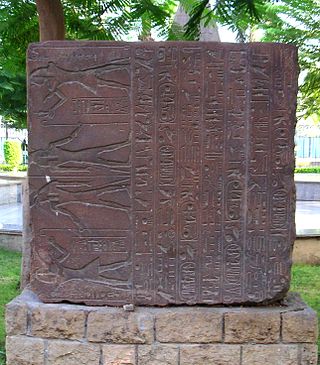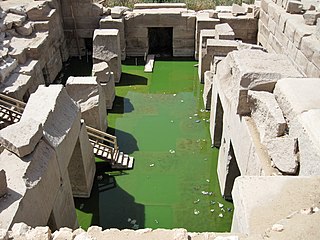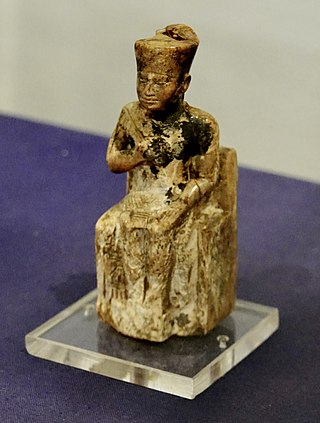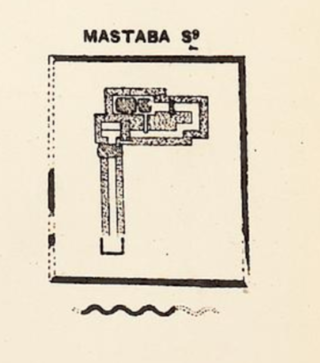
Abydos is one of the oldest cities of ancient Egypt, and also of the eighth nome in Upper Egypt. It is located about 11 kilometres west of the Nile at latitude 26° 10' N, near the modern Egyptian towns of El Araba El Madfuna and El Balyana. In the ancient Egyptian language, the city was called Abedju (Arabic Abdu عبد-و). The English name Abydos comes from the Greek Ἄβυδος, a name borrowed by Greek geographers from the unrelated city of Abydos on the Hellespont. Abydos name in hieroglyphs

Memphis, or Men-nefer, was the ancient capital of Inebu-hedj, the first nome of Lower Egypt that was known as mḥw ("North"). Its ruins are located in the vicinity of the present-day village of Mit Rahina, in markaz (county) Badrashin, Giza, Egypt. This modern name is probably derived from the late Ancient Egyptian name for Memphis mjt-rhnt meaning "Road of the Ram-Headed Sphinxes".

Nekhen, also known as Hierakonpolis was the religious and political capital of Upper Egypt at the end of prehistoric Egypt and probably also during the Early Dynastic Period.

Umm El Qaʻāb is a necropolis of the Early Dynastic Period kings at Abydos, Egypt. Its modern name means "Mother of Pots" as the whole area is littered with the broken pot shards of offerings made in earlier times. The cultic ancient name of the area was (w-)pkr or (rꜣ-)pkr "District of the pkr[-tree]" or "Opening of the pkr[-tree]", belonging to tꜣ-dsr "the secluded/cleared land" (necropolis) or crk-hh "Binding of Eternity".

Athribis was an ancient city in Lower Egypt. It is located in present-day Tell Atrib, just northeast of Benha on the hill of Kom Sidi Yusuf. The town lies around 40 km north of Cairo, on the eastern bank of the Damietta branch of the Nile. It was mainly occupied during the Ptolemaic, Roman, and Byzantine eras.

El Lahun. It was known as Ptolemais Hormos in Ptolemaic Egypt.

Khasekhemre Neferhotep I was an Egyptian pharaoh of the mid Thirteenth Dynasty ruling in the second half of the 18th century BC during a time referred to as the late Middle Kingdom or early Second Intermediate Period, depending on the scholar. One of the best attested rulers of the 13th Dynasty, Neferhotep I reigned for 11 years.

Nubkheperre Intef was an Egyptian king of the Seventeenth Dynasty of Egypt at Thebes during the Second Intermediate Period, when Egypt was divided by rival dynasties including the Hyksos in Lower Egypt.

Sekhemre Wahkhau Rahotep was an Egyptian pharaoh who reigned during the Second Intermediate Period, when Egypt was ruled by multiple kings. The Egyptologists Kim Ryholt and Darrell Baker believe that Rahotep was the first king of the 17th Dynasty.

John Garstang was a British archaeologist of the Ancient Near East, especially Egypt, Sudan, Anatolia and the southern Levant. He was the younger brother of Professor Walter Garstang, FRS, a marine biologist and zoologist. Garstang is considered a pioneer in the development of scientific practices in archaeology as he kept detailed records of his excavations with extensive photographic records, which was a comparatively rare practice in early 20th-century archaeology.

The Osirion or Osireion is the cenotaph of Seti I, located to the rear of the Temple of Seti I at Abydos, Egypt.
Kom el-Hisn is a Nile Delta settlement dating back to the Old Kingdom of Egypt with parts dating to the Middle Kingdom. Its location in the 3rd nome of Lower Egypt, or "House of the Lord of Ships ", focus on the goddess Hathor, as well as faunal and textual evidence suggests it played a role in transporting cattle between regions. Whether or not it was a self-sufficient town or built solely to support the temple is currently unknown.

David Bourke O'Connor was an Australian-American Egyptologist who primarily worked in the fields of Ancient Egypt and Nubia.
Beit Khallaf is a small rural village located 10 kilometers west of Girga in Upper Egypt. Beit Khallaf is part of the area known as the Hajer line, which is composed of three other villages: Beit Allam, Beit Khuraybi, and Beit Dawud Sahl. As of 2006, the total population of the village is 10,895 people. The area has several mastabas and burial sites and is governed by the Egyptian ministry of Antiques as an Ancient Archeological site.
Josef William Wegner is an American Egyptologist, archaeologist and Professor in Egyptology at the department of Near Eastern Languages and Civilizations of the University of Pennsylvania, where he obtained his Ph.D. degree in Egyptology in 1996. He specializes in Egyptian Middle Kingdom archaeology. His father is the astrophysicist, Gary A. Wegner.

The following outline is provided as an overview of a topical guide to ancient Egypt:

Several ancient Egyptian solar ships and boat pits were found in many ancient Egyptian sites. The most famous is the Khufu ship now preserved in the Grand Egyptian Museum. The full-sized ships or boats were buried near ancient Egyptian pyramids or temples at many sites. The history and function of the ships are not precisely known. They might be of the type known as a "solar barge", a ritual vessel to carry the resurrected king with the sun god Ra across the heavens. However, some ships bear signs of being used in water, and it is possible that these ships were funerary barges.

The Khufu Statuette or the Ivory figurine of Khufu is an ancient Egyptian statue. Historically and archaeologically significant, it was found in 1903 by Sir William Matthew Flinders Petrie during excavation of Kom el-Sultan in Abydos, Egypt. It depicts Khufu, a Pharaoh of the Fourth dynasty, and the builder of the Great Pyramid, though it may have been carved much later, in the Twenty-Sixth Dynasty, 664 BC–525 BC.

S 10 is the modern name given to a monumental ancient Egyptian tomb complex at Abydos in Egypt. The tomb is most likely royal and dates to the mid-13th Dynasty. Finds from nearby tombs indicate that S10 suffered extensive state-sanctioned stone and grave robbing during the Second Intermediate Period, only a few decades after its construction, as well as during the later Roman and Coptic periods. These finds also show that S10 was used for an actual burial and belonged to a king "Sobekhotep", now believed to be pharaoh Sobekhotep IV. According to the Egyptologist Josef W. Wegner who excavated S10, the tomb might originally have been capped by a pyramid, although Aidan Dodson states that it is still unclear whether S10 was a pyramid or a mastaba.

S 9 is the modern name given to a monumental ancient Egyptian tomb complex at Abydos in Egypt. The tomb is most likely royal and dates to the mid-13th Dynasty, during the late Middle Kingdom. Finds from the area of the tomb indicate that S9 suffered extensive, state-sanctioned stone and grave robbing during the Second Intermediate Period, only a few decades after its construction, as well as during the later Roman and Coptic periods. Although no direct evidence was found to determine the tomb owner, strong indirect evidence suggest that the neighbouring and slightly smaller tomb S10 belongs to pharaoh Sobekhotep IV. Consequently, S9 has been tentatively attributed by the Egyptologist Josef W. Wegner to Sobekhotep IV's predecessor and brother, Neferhotep I . According to Wegner, the tomb might originally have been capped by a pyramid.

















